
Cornish Settlement/Byng Stories — Number 1
Charles Allcorn - Resident of Byng
Introduction
We have received a series of emails which have contained family history of Charles Allcorn who started out life in difficult circumstances in Brighton, Sussex England and came to Australia as a young lad in 1854. He eventually bought a block of land in Byng NSW and set himself up as a bootmaker.
This has all come to us from Phillip Allcorn who lives in Western Australia but frequently has to travel north from Perth in that State. We have corresponded for some time and recently Phillip has sent his latest files on Charles Allcorn, his wife whom he married in Orange and information on their three children. In case you might think that your Webmaster has suddenly developed problems with his typing, the original surname is spelt Allcorn but some of the family chose later to spell it Alcorn. Phillip has given us some graphics from his personal files in WA and directed us to stories about the Brighton Workhouse where Charles Allcorn spent some years of his young life. He has also suggested that we arrange for a section of the Byng Parish Map to be reproduced. We have obtained copyright permission from the author of the Workhouse Web site and from the NSW Department of Information Technology and Management, Land and Property Information. The whole story is wonderful, based as it is about the Allcorn family in Cornish Settlement, now Byng, and surrounding areas.
Charles Allcorn
Birth: 1840 — Brighton SSX, England Death: 9 Dec 1915 - Millthorpe NSW AUS
Father: Thomas Allcorn ( — ) Mother: Susanna Measor (1802-1845)
Spouse : Mary Ann Harvey (1844 - 1921)
Married: 9 Jun 1864
Orange NSW AUS
|
Children:
1. Benjamin Charles Alcorn (22 Jun 1875 - 2 Feb 1962)
2. Alf Alcorn (1869 - )
3. Jane Alcorn (1867 - 2 Dec 1933) |
A Difficult Start in Life
Charles Allcorn is listed in the 1851 UK census as being in the Brighthelmstone workhouse at Brighton SSX ENG, aged 11, a pauper and an orphan. There is also a Louisa Allcorn, pauper and orphan aged 6. They were under the tutelage of a 66 year old master shoemaker, Thomas Andrews. The records for Brighton workhouse for this period did not survive so that information about Charles is very sketchy.
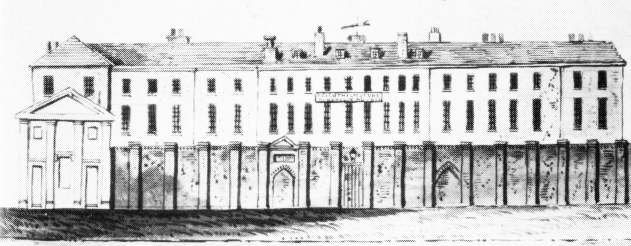 From a plate published in 'Illustrated History of Brighton' by John Ackerson Erridge, published 1862
From a plate published in 'Illustrated History of Brighton' by John Ackerson Erridge, published 1862
Brighthelmstone Workhouse, Church Hill, Brighton, Sussex (above the graveyard of St. Nicholas' Church)
designed by William Mackie of London, built 1820-1822 by John Cheesman.
The inscription over the main door reads -
Brighthelmston Poor-house,
Erected AD., 1821
Vicar, Rev. R. J. Carr, D.D.
Churchwardens Edward Blaker, Robert Ackersall, Richard Brodie
Material and photographs presented on this page, giving the background and history of the Brighthelmstone Workhouse, have derived from two Web sites for which grateful acknowledgement is given. The first is the Peter Higginbotham Web site, under copyright to Peter Higginbotham, and the second is the John Hoare Web site, under copyright to John Hoare. Both have provided wonderful background to the Brighthelmstone Workhouse and its history. We are grateful for the permission John Hoare and Peter Higginbotham have given to use their copyright material and images because they add to the story of Charles Allcorn in his early life, before leaving for Australia. If you wish to view this material from a separate page and then return to this page, go to the Brighthelmstone story.
The Beginning of a New Life
Charles arrived in Australia on 3 September 1854, aboard the brig Tantivy. From the passenger list details, he is logged as being 15 years old, a shoemaker from Brighton, Sussex. He lists his relations in the colony as a brother Alfred living in Sydney (see below). The log also notes that he can read and write, with no complaints about his treatment aboard ship. Charles has listed his parents as "William? and Susanna". This does not fit with later certificates showing "Thomas" as his father. Phillip Allcorn has provided some more information on "his relations in the colony".
Charles' brother Alfred and sister Susanna
Alfred Allcorn was born the son of Thomas Allcorn and Susanna (nee Measor). He was christened at St Nicholas Church in Brighton on 24 August 1823. The family lived in Kings Street Brighton where Thomas had his bootmaker's business. The family must have fallen on hard times around 1840 as Susanna Allcorn was found to be in the Brighton Workhouse in 1841 but no record about Thomas has been found.
Alfred married Ann (Martin?) from Avingdean in 1847 and they appear to have decided to try a new life in the colonies. The couple obtained emigrant status and boarded the ship Steadfast. They took with them Alfred's sister, then a 20 year old housemaid.The decision to emigrate must have been a terrible one because they were leaving behind their brother Charles and sister Louisa in the Brighton Workhouse.
The Steadfast had left Deptford in London for Plymouth and 20 October 1848 and had a bad voyage there with passengers suffering fever. The ship was put in quarantine in Plymouth, passengers put on shore and the ship was fumigated and cleansed. It did not leave Plymouth until 25 November. 20 of the London passengers were left in Plymouth and the other emigrants were added to the passenger list, a total of 213 in all. The ship was given a clean bill of health. Excerpts from the Steadfast Log and the Medical and Surgical Report are held by Phillip Allcorn. He has extracted references to the Allcorn passengers which are interesting. Ann Allcorn suffered from a fever on 25 November but was assessed cured by 6 December. Susan Allcorn suffered bronchitis on 6 December but was assessed as cured on 14 December There is also a record in the log that Mr Alfred Allcorn was given an appointment as assistant schoolmaster for his most exemplary good conduct while on board.
Nevertheless, during the long trip of 120 days, there was an outbreak of typhus fever, scarlatina and measles again, a rather dreadful voyage reported on both in England and the Sydney press. There were 13 deaths of which about ten were infants. The Steadfast arrived in Sydney on 29 March 1849 and the Health Officer of the Port of Sydney put her in quarantine for a few days, transferring the passengers to the quarantine station. It was not a good introduction to Australia.
Alfred and Ann did settle in NSW and were living in the St George suburb of Sydney for a period after their arrival. However, Alfred died in 1858, only nine years after making the journey. There appear to have been no children. Ann remarried subsequently to Charles Lusted at St George in 1865. The sister of Alfred and Charles, Susanna, married Benjamin Hardaker (so spelt in the NSW records) in 1851 at the Independent Congregational Church in Pitt Street Sydney. This makes it quite clear that Charles Allcorn certainly had relations in the Sydney area and they would have had the delight of seeing Charles when he arrived in Sydney in 1854. Now let us return to Charles and his life at the Cornish Settlement/Byng.
Charles Allcorn in Byng
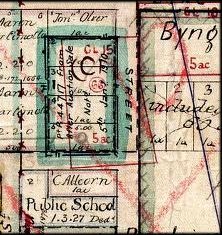
|
The 1887 Parish Map of the township of Byng NSW shows the block
which Charles Allcorn had purchased to build a bootmaker's shop.
Source of map: © Land and Property Information
Panorama Avenue Bathurst NSW 2795
LPI web site URL
LPI permission to reproduce is hereby acknowledged.
|
At Orange NSW in 1864, Charles Allcorn married Mary Ann Harvey who was born in the Cornish Settlement (Byng). We are fortunate in having photographs of Charles Allcorn and Mary Ann Harvey which Phillip Allcorn obtained from an Aunt. The dates on which these photographs were taken are not certain. Both would have been early in their lives with the one of Mary Ann about the time of her marriage.
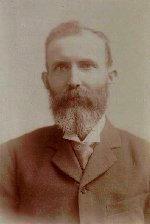
Charles Allcorn
Photograph by Beavis Bros
Bathurst, NSW Royal Studio |
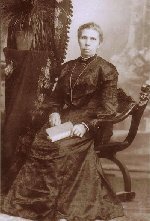
Mary Ann Harvey
Photograph by
W.H. Bursle, Orange |
They had 3 children; Benjamin, Alf and Jane. The family mainly stayed in the Byng / Emu Swamp area.
At this stage in Phillip Allcorn's history collection, we are not able to provide further information about Charles and Mary Ann in their life at Byng but we do have a photograph of Mary Ann later on in her life. We also have material about Benjamin Alcorn (so spelt) and his photograph in the prime of life, so we provide that part of the Allcorn history as well.
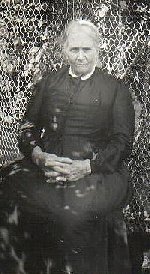 |
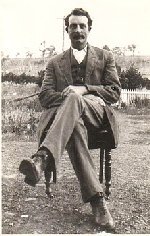
Left: Mary Ann Allcorn
Above: Benjamin C. Alcorn |
Benjamin Charles Alcorn
Born: 22 Jun 1875 - Emu Swamp NSW
Death: 2 Feb 1962 - Cheesemans Creek NSW
Burial: 5 Feb 1962 - Orange Cemetery
Parents: Father: Charles Allcorn (1840-1915) Mother: Mary Ann Harvey (1844-1921)
Spouse and Children:
Laura Selina Boulton (1872 - 1955)
Marriage: 15 Feb 1899 - Wesleyan Parsonage, Anson St., Orange NSW AUS
Children:
1. Theophilus Allcorn (8 Oct 1902 - 7 Mar 1980)
2. Emily Alcorn
3. Cecil Alcorn (1904 - 21 Mar 1967)
4. Frank Alcorn (15 Jan 1910 - )
5. Ralston (Roy) Alcorn (1900 - )
Notes
Ben was one of five children born to Charles and Mary Ann. He was educated at Byng Public school. Before 1900 he worked for the Oates family of Belgravia. In 1899 Ben married Laura Selina Boulton at the Wesleyan Parsonage in Orange. Laura made the suit he wore to the wedding and they started their married life with just £15. Ben and his wife moved to Emu Swamp (near Lucknow NSW) where they rented a farm from William Hawke of Pendarvis. The farm was of some 320 acres and adjoined that of Ben's brother-in-law Ern Boulton. The two properties were run together for some time.
The farm was mainly dairying although vegetables and eggs, as well as butter and cream, were sold locally. There was a considerable trade on the barter system, with wages paid sometimes in part with meat and vegetables, e.g. Ben sold 1 cwt of pumpkin to Mrs Chegwidden (who ran a boarding house in Orange) for 5/-. She gave him a dinner on the same day costing 1/-, with four meals to come.
Much of the information about Ben's dealings came from his "day books", transcribed by the Molong Historical Society (The Molong Historian, Vol.2, No.3). One entry outlines a recipe for "Bot" fly (1908);
"Get the horse nice and soft inside with Bran, then get an ounce of Tansy, put on same one quart of water and boil down to about 1 pint. Give the horse this in about a quart of new milk. Keep the horse still on the bran, and then drench with 1 pint of linseed oil mixed with a small bottle of castor oil."
On the 22 of February 1913, Ben purchased the property at Cheeseman's Creek from T.J. Robinson. It comprised an area of 477 acres and 38 perches. The price was £6 per acre, making the total of £2863, 8 shillings to be paid, and the balance of £2,505 to be paid over the next 31 years (with interest). The house included what used to be an old Cobb & Co hotel, which then became the Cheeseman's creek Post Office. Ben assumed the position of Postmaster from Fred Williamson in 1916.
On getting possession of the property that he named Fernleigh, Ben gradually shifted his stock from the leased property at Emu Swamp. In April 1913, 345 sheep (mostly ewes) were sent. F. Dunbar was the drover who took 8 head of cattle out. In May, 100 wethers and 14 cattle went out, and a further 14 cattle in August. The following year in February, 142 wethers were sent to Fernleigh and in April 1914, 388 wethers.
Through the following years, Ben acquired more land, some of that being a 60 acre reserve on the opposite side of the road to the Post Office, which was divided in 1918. (Ben and Jack Wythes each bought half). The other property was Ryan Park which is a 528 acre block to the south of Fernleigh which Ben bought in 1926. Ben started investing in Real Estate in Orange, buying and renting houses and in this way acquired about 6 homes. At Fernleigh, he had a tennis court built and weekends saw crowds of young people gathering there.
Having the only shearing shed in Cheeseman's Creek, Ben did the shearing for nearby properties. After he built a sheep dip in 1919, he also did the dipping for them. The main feature of the business was the continual stock dealing in pigs, cattle and sheep, and to a much smaller extent, horses. With the sheep, he started to concentrate more on the crossbred lambs (Romney and Corriedale). Most of these sales were conducted through the Orange saleyards with some dealings through Flemington and Homebush in Sydney. The families income came also through selling butter and cream, both to the Butter Factory and to neighbours.
Ben continued as the postmaster at Cheeseman's Creek until 1955 when Laura died. His son Theo and daughter-in-law Jessie then moved in to look after him, with Jessie taking on the job of Post Mistress. Ben continued his dealings in real estate and the stock from his properties until his death in 1962.
Research about the Brighton Workhouse
Brighton Workhouse, Church Hill, Brighton, Sussex (above the graveyard of St. Nicholas' Church) was designed by William Mackie of London, built 1820-1822 by John Cheesman.
The inscription over the main door reads —
Brighthelmston Poor-house,
Erected AD 1821
Vicar, Rev. R. J. Carr, D.D.
Churchwardens Edward Blaker, Robert Ackersall, Richard Brodie
Brighthelmston Workhouse
As the population increased, the old building was found insufficient to answer the purposes for which it was intended, and accordingly, in 1821, the present workhouse was commenced: it stands on Church Hill, near the parish church of St. Nicholas, on a spot particularly adapted for such an establishment from the airiness of its situation. The house is 191 feet in length, and is divided into four distinct parts in order to class its inmates in the most regular manner.
The central division consists of an entrance-hall, working room, and committee-room for examination of applicants, the overseers and clerk's office, and the governor's room, and also proper sleeping apartments. Adjoining to these rooms to the North, are apartments for females, including sick persons, lying-in women, children in the nursery, and all females not capable of executing laborious work.
In the next division of the house, which forms the North wing, are wards for males not capable of doing hard work. These wards are fifty feet in length and twenty-five in depth, and consist of sleeping-rooms, eating-rooms, proper places for the sick, and a school for boys.
The Southern division of the house, adjoining the centre, comprises apartments for males who are able to work: its upper storey is divided into sleeping-rooms, and the lower storeys consist of workrooms, a school-room and an eating-room.
Each of these divisions opens into a separate yard. That belonging to the South wing contains in it a mill for grinding corn, a manufactory of very excellent whiting, and workshops for dressing flax, carding wool, &c. The flour consumed in the house is ground by the paupers. They also manufacture and make up their own clothing, and prepare for sale, whiting, ropes, cords, door-mats, rugs, sacking of every description, and other articles.
The South wing, which forms the next division, is of the same dimensions as that on the North, and is separated into sleeping-rooms, an eating-room, and a work-room.
Behind the central division, already mentioned, is a lofty kitchen, a wash-house, brew-house, bake-house, and a very spacious laundry, in the fitting up and furnishing of which every regard has been paid to the cleanliness, convenience, and comfort of the inmates. There is a garden of about nine acres attached to the Workhouse.
At a short distance from the house an Infirmary has been erected for the reception of the sick paupers.
Workhouse Schools
Under the 1834 Act, Poor Law Unions were required to provide at least three hours a day of schooling for workhouse children, and to appoint a schoolmaster and/or schoolmistress. The children were taught "reading, writing, arithmetic, and the principles of the Christian Religion, and such other instruction as may fit them for service, and train them to habits of usefulness, industry and virtue".
It is very apparent that the school produced one young man who made his way around the world to a new totally different abode and that he showed how well the "habits of usefulness, industry and virtue" had been developed for him and in him. We have had great delight in preparing this Web page for others to read such a wonderful family story, based in the history of the Cornish Settlement and Byng.
Return to Byng and Cadia Family Stories






